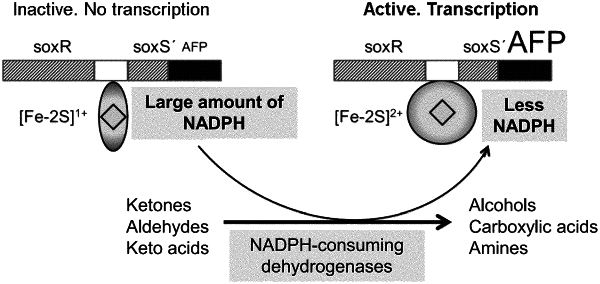| CPC G06Q 10/06395 (2013.01) [A61K 31/07 (2013.01); C12N 15/70 (2013.01); C12Q 1/6897 (2013.01); C12Y 101/00 (2013.01); G06N 3/006 (2013.01); G06N 5/045 (2013.01); G06Q 10/04 (2013.01); C12Q 1/26 (2013.01); C12Q 1/68 (2013.01)] | 8 Claims |

|
1. A method for isolating genes which code for NADP(H)-dependent enzymes, comprising the method steps:
(I) providing an NADP(H) nanosensor comprising
i) a first nucleic acid, the first nucleic acid having a nucleic acid sequence to which a regulator is capable of binding, wherein an oxidation state of the regulator depends on NADP(H) availability;
ii) a second nucleic acid following the first nucleic acid i), the second nucleic acid having a promoter sequence to which an RNA polymerase is capable of binding, wherein an affinity of the RNA polymerase for the promoter sequence is influenced by the oxidation state of the regulator;
iii) a third nucleic acid, the third nucleic acid having a nucleic acid sequence which is under the control of the second nucleic acid ii), the third nucleic acid having a nucleic acid sequence which codes for an autofluorescent protein;
(II) introducing the NADP(H) nanosensor into a cell to form a cell suspension;
(III) introducing a gene which may code for an NADP(H)-dependent enzyme into individual cells of the cell suspension obtained in method step (II);
(IV) incubating the cells obtained in method step (III) with a substrate for the NADP(H)-dependent enzyme;
(V) identifying individual cells in the cell suspension obtained in method step (IV) with an increased activity of NADP(H)-dependent enzymes by detection of intracellular fluorescence activity of the individual cells, wherein the presence of the NADP(H)-dependent enzyme in the individual cells increases expression and production of the autofluorescent protein, leading to the increased fluorescent activity;
(VI) separating off the identified cells from the cell suspension;
(VII) isolating the genes coding for an NADP(H)-dependent enzyme in the identified cells;
wherein components i) and ii) are comprised in a nucleic acid having a nucleic acid sequence selected from the group consisting of:
a) a nucleic acid sequence according to SEQ. ID. No. 01, and
b) a nucleic acid sequence which has an identity of at least 99% to the nucleic acid sequence of a),
wherein the regulator is SoxR regulator and the promoter sequence is a sequence of soxS promoter, the nucleic acid sequence of a) or b) being able to bind SoxR regulator such that the affinity of the RNA polymerase for the soxS promoter depends on the oxidation state of SoxR regulator.
|